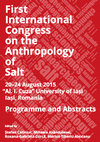Books edited by Argelia del Carmen Montes Villalpando

by Marius Alexianu, Mihaela Asăndulesei, Valentin Arapu, Andrei Emilciuc, Martin Hees, Argelia del Carmen Montes Villalpando, Mădălina Necula, Tamara Montalvo-Arce, Edoardo Vanni, Sorin Stratulat, Mera Ovidiu, Konrad A. Antczak, Oriol Beltran, Robin Brigand, Neculai Bolohan, Blas Román Castellón Huerta, Cavruc (Kavruk) Valeriu (Valerii), Jorge A. Ceja Acosta, Franck Derrien, Maciej Dębiec, Diaconu Vasile, Ashley A Dumas, Alfons Fíguls Alonso, Mircea-Cristian Ghenghea, Elisa Guerra Doce, Catherine Liot, Ileana Oana Macari, Nuria Morere, Ivana Pandzic, Razvan Victor Pantelimon, Alex Popa, Gustavo Ramirez, alfonso stiglitz, Felix-Adrian Tencariu, Edoardo Vanni, Olivier Weller, Igor Lyman, Victoria Konstantinova, Iuri (Gheorghe) Simionca, Tasha Maroulis, Rosa Maria Lanaspa, and Coralie GRADEL Common salt (sodium chloride) is an invisible object for archaeological research, but the ancient... more Common salt (sodium chloride) is an invisible object for archaeological research, but the ancient texts, the history, the ethnography and our everyday life confirm that both Man and Animal cannot live without it. Salt is a primordial reference for humanity. This “fifth element” is universal in a double sense, diachronically and diatopically. How can archaeology and related disciplines or sciences approximate this soluble good, this “white gold”, this invisible past?
From the diatopic and diachronic perspective, common salt—with all its natural or artificial metamorphoses—has influenced humanity in the most diverse aspects. This is why, within a brief enumeration, the salt-related research themes are intriguingly various: explorations (hunting for salt), exploitation techniques, techniques to obtain different products, exploitation and use tools, transport and storage containers, human and animal feeding, conservation (meat, bacon, cheese, vegetables, green goods, fruits). The themes also include manufacture-related uses (including the construction of salt houses), mythology, religion, cult, rituals, beliefs, superstitions, mentalities, secret societies, magic, vows, curses, prohibitions, popular medicine, sexuality, economy, hide working, population, alchemical procedures, scientific and cultural representations, treatment of the deceased, barter, commerce, contraband, robbery.
On the other hand, the themes also include human and animal mobility, the attraction exerted on savage beasts, symbolic uses, folk literature (stories, tales, and proverbs) and cult literature, the control of salt resources, conflicts, strategic value, geographic perceptions, professions related to salt exploitation and uses, economic, legal and administrative regulations, vocabulary, toponymy, anthroponomy and the list can go on.
All these themes already constitute a study object for an impressive number of sciences, disciplines, or sub-disciplines, such as archaeology, heritage studies, history, ethnography, ethnoarchaeology, economic anthropology, food sciences, statistics, sociology, geology, mineralogy, geography, hydrology, botany, chemistry, medicine, pharmacology, ethology, theology, agronomy, symbology, linguistics, folklore studies, cultural studies, literary studies, hermeneutics, legal sciences, etc. Obviously, some themes must be approached only in an interdisciplinary vision.








Uploads
Books edited by Argelia del Carmen Montes Villalpando
From the diatopic and diachronic perspective, common salt—with all its natural or artificial metamorphoses—has influenced humanity in the most diverse aspects. This is why, within a brief enumeration, the salt-related research themes are intriguingly various: explorations (hunting for salt), exploitation techniques, techniques to obtain different products, exploitation and use tools, transport and storage containers, human and animal feeding, conservation (meat, bacon, cheese, vegetables, green goods, fruits). The themes also include manufacture-related uses (including the construction of salt houses), mythology, religion, cult, rituals, beliefs, superstitions, mentalities, secret societies, magic, vows, curses, prohibitions, popular medicine, sexuality, economy, hide working, population, alchemical procedures, scientific and cultural representations, treatment of the deceased, barter, commerce, contraband, robbery.
On the other hand, the themes also include human and animal mobility, the attraction exerted on savage beasts, symbolic uses, folk literature (stories, tales, and proverbs) and cult literature, the control of salt resources, conflicts, strategic value, geographic perceptions, professions related to salt exploitation and uses, economic, legal and administrative regulations, vocabulary, toponymy, anthroponomy and the list can go on.
All these themes already constitute a study object for an impressive number of sciences, disciplines, or sub-disciplines, such as archaeology, heritage studies, history, ethnography, ethnoarchaeology, economic anthropology, food sciences, statistics, sociology, geology, mineralogy, geography, hydrology, botany, chemistry, medicine, pharmacology, ethology, theology, agronomy, symbology, linguistics, folklore studies, cultural studies, literary studies, hermeneutics, legal sciences, etc. Obviously, some themes must be approached only in an interdisciplinary vision.
From the diatopic and diachronic perspective, common salt—with all its natural or artificial metamorphoses—has influenced humanity in the most diverse aspects. This is why, within a brief enumeration, the salt-related research themes are intriguingly various: explorations (hunting for salt), exploitation techniques, techniques to obtain different products, exploitation and use tools, transport and storage containers, human and animal feeding, conservation (meat, bacon, cheese, vegetables, green goods, fruits). The themes also include manufacture-related uses (including the construction of salt houses), mythology, religion, cult, rituals, beliefs, superstitions, mentalities, secret societies, magic, vows, curses, prohibitions, popular medicine, sexuality, economy, hide working, population, alchemical procedures, scientific and cultural representations, treatment of the deceased, barter, commerce, contraband, robbery.
On the other hand, the themes also include human and animal mobility, the attraction exerted on savage beasts, symbolic uses, folk literature (stories, tales, and proverbs) and cult literature, the control of salt resources, conflicts, strategic value, geographic perceptions, professions related to salt exploitation and uses, economic, legal and administrative regulations, vocabulary, toponymy, anthroponomy and the list can go on.
All these themes already constitute a study object for an impressive number of sciences, disciplines, or sub-disciplines, such as archaeology, heritage studies, history, ethnography, ethnoarchaeology, economic anthropology, food sciences, statistics, sociology, geology, mineralogy, geography, hydrology, botany, chemistry, medicine, pharmacology, ethology, theology, agronomy, symbology, linguistics, folklore studies, cultural studies, literary studies, hermeneutics, legal sciences, etc. Obviously, some themes must be approached only in an interdisciplinary vision.